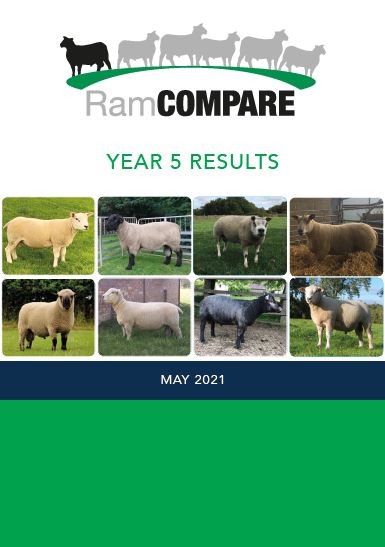- Home
- News
- RamCompare five-year results identifies traits from performance recorded rams to drive flock productivity
RamCompare five-year results identifies traits from performance recorded rams to drive flock productivity
Thursday, 20 May 2021
The fifth-year results from the RamCompare project reveal how rams with key breeding traits can drive productivity and optimise flock profitability.
The breeding research project demonstrates how commercial producers can use specific estimated breeding values (EBVs) to identify rams with a high genetic potential and prove their worth when assessing financial impact.
Phase II of the RamCompare project was completed in December 2020 and funding has recently been announced to develop a third phase of the project over the next five years.
RamCompare uses nominated performance-recorded rams from various terminal sire breeds on commercial farms across the UK. To date, this joint levy funded project has recorded the performance of over 26,000 lambs sired by 280 rams through artificial insemination (AI) and natural mating over five breeding seasons.
Once again, the latest update shows a great spread of rams among the most recent lists of trait leaders. Signet Breeding Manager, Sam Boon, urges breeders to focus on those traits that deliver the greatest profit to their system and source recorded rams with the right EBVs to deliver them.
“Within the groups of high genetic merit sires used we have identified differences in progeny values worth £4-£6 per lamb, providing farmers with the opportunity to enhance flock profitability through careful ram selection. This equates to £1200-£1500 per ram during their working lifetime. Few rams can do it all; some will excel for carcase conformation, others for speed of finish. Producers should therefore evaluate their system and determine which sires have the potential to make the biggest financial impact.”
Despite the challenges that arose in 2020 with the outbreak of Covid-19, the project was still able to complete full abattoir datasets from each farm and collect ultrasound scanning data from most of them. Unfortunately, due to the restrictions, the Shearforce evaluations were not able to be completed this season. The Shearforce breeding value provides an indication of meat tenderness and this table will be updated later when access to the lab can resume.
With thanks to the dedication displayed by Dunbia and Randall Parker throughout the past five years, carcases have been dissected to assess primal yields at a fixed weight to provide specific breeding values for the carcase weights, front, middle and haunch.
The UK sheep industry shows an extensive range of genetic variation with a wealth of opportunities, with six different breeds topping at least one of the RamCompare leader tables. Ultimately, decisions on commercial farms should reflect the profitability of each trait to the enterprise – and this varies with production systems and end market. RamCompare clearly shows the benefit of EBV based ram selection to enhance those traits on which producers are paid.
View the full results online at www.ramcompare.com where there is also a range of case studies which show how ram purchase decisions influence outcomes at farm level. The key findings are shown as an economic value to demonstrate the financial gain achieved on these commercial systems due to careful ram selection.
Buyers can access the RamCompare data online to see a ram’s genetic ranking for specific traits such as scan weight (growth rate) or muscle depth. Signet recorded stock can be found at www.signetdata.com, which provides lists of sheep for sale, as well as “Flock Finder” which indicates performance recorded flocks located nearby.
For more information on the RamCompare project, including a downloadable copy of the latest results, please visit www.RamCompare.com
This work is led by Samuel Boon and Bridget Lloyd. For further information please contact the AHDB Beef & Lamb marketing communications team BeefLamb.Comms@ahdb.org.uk



